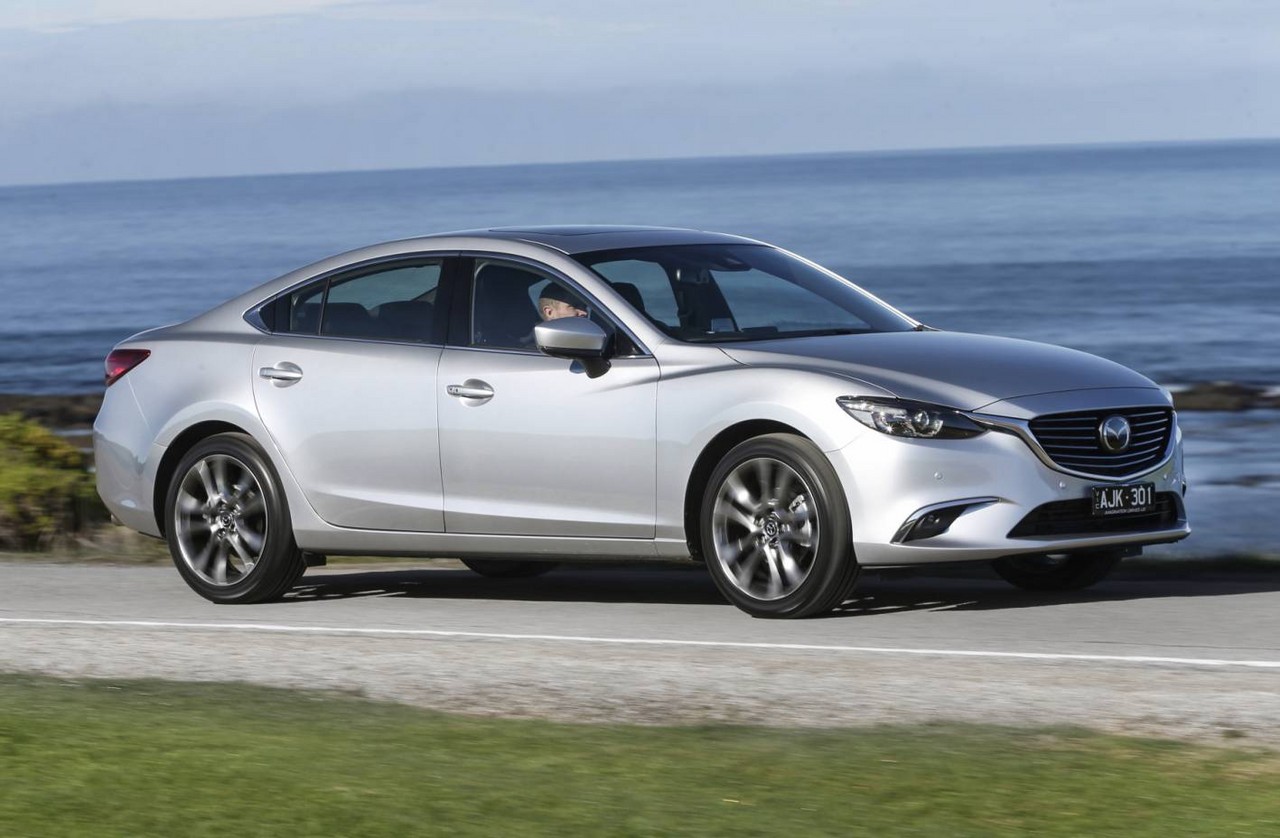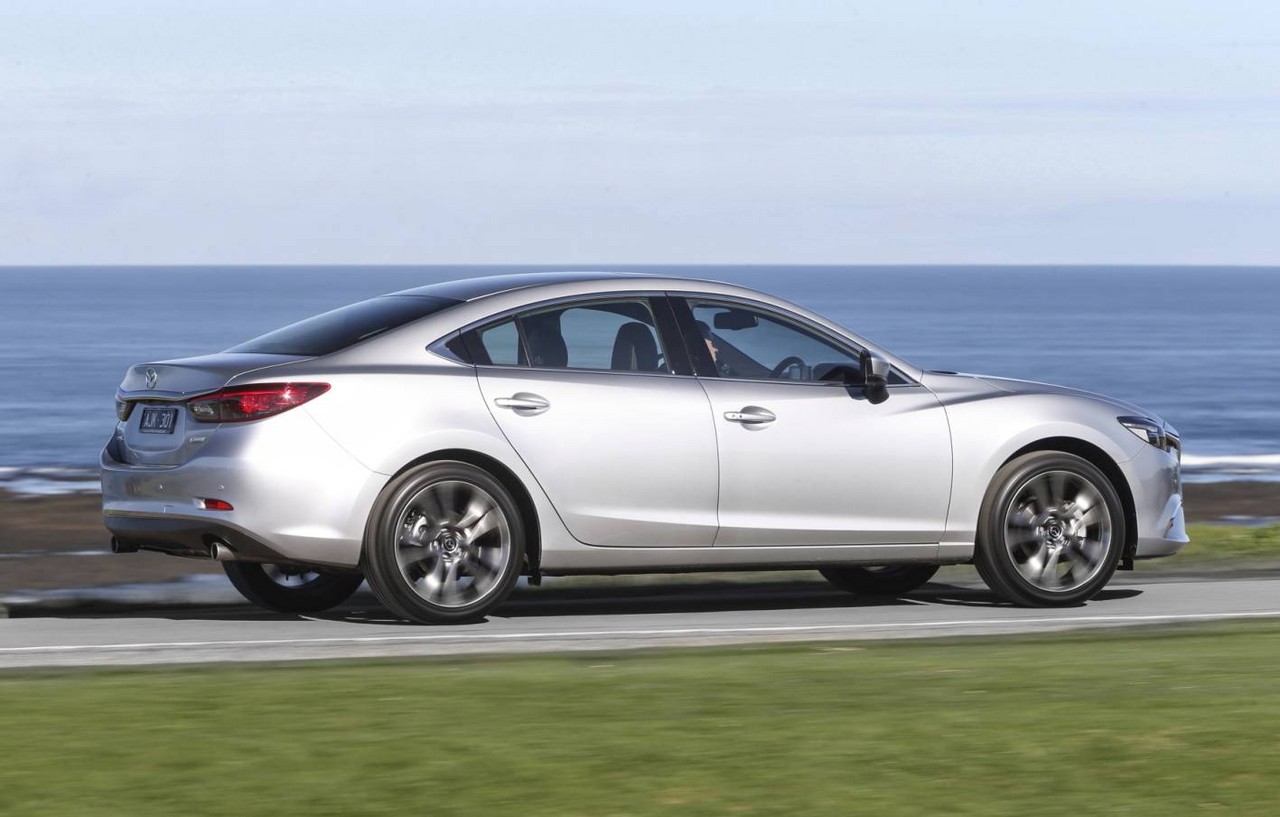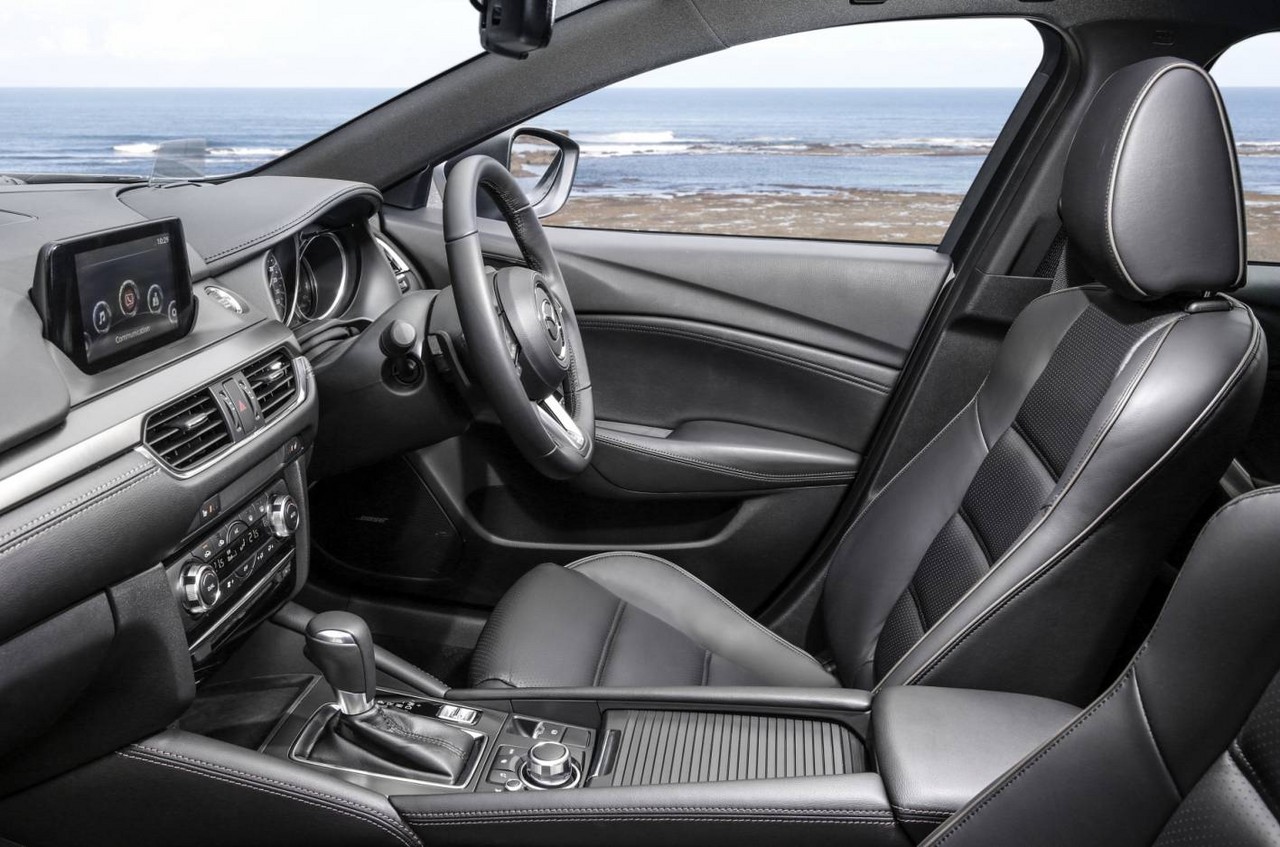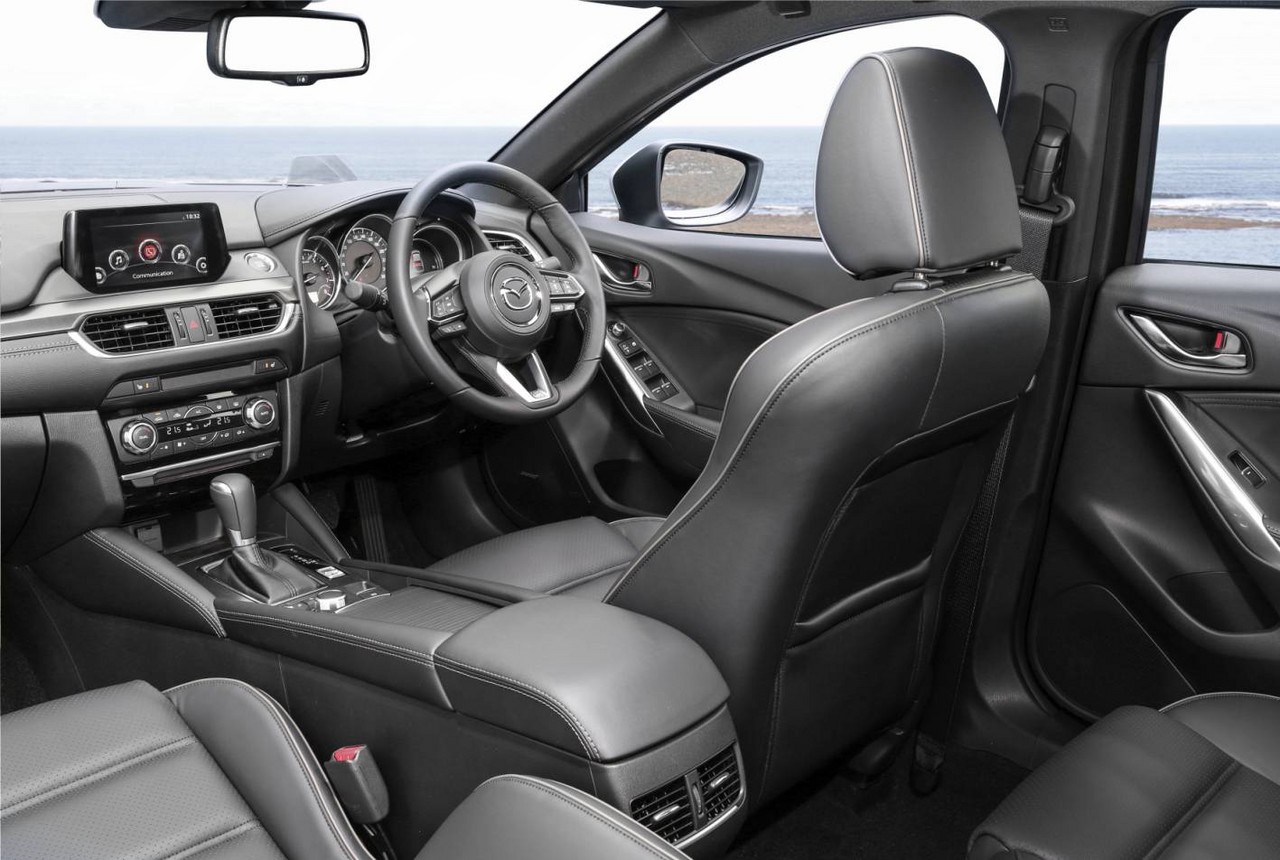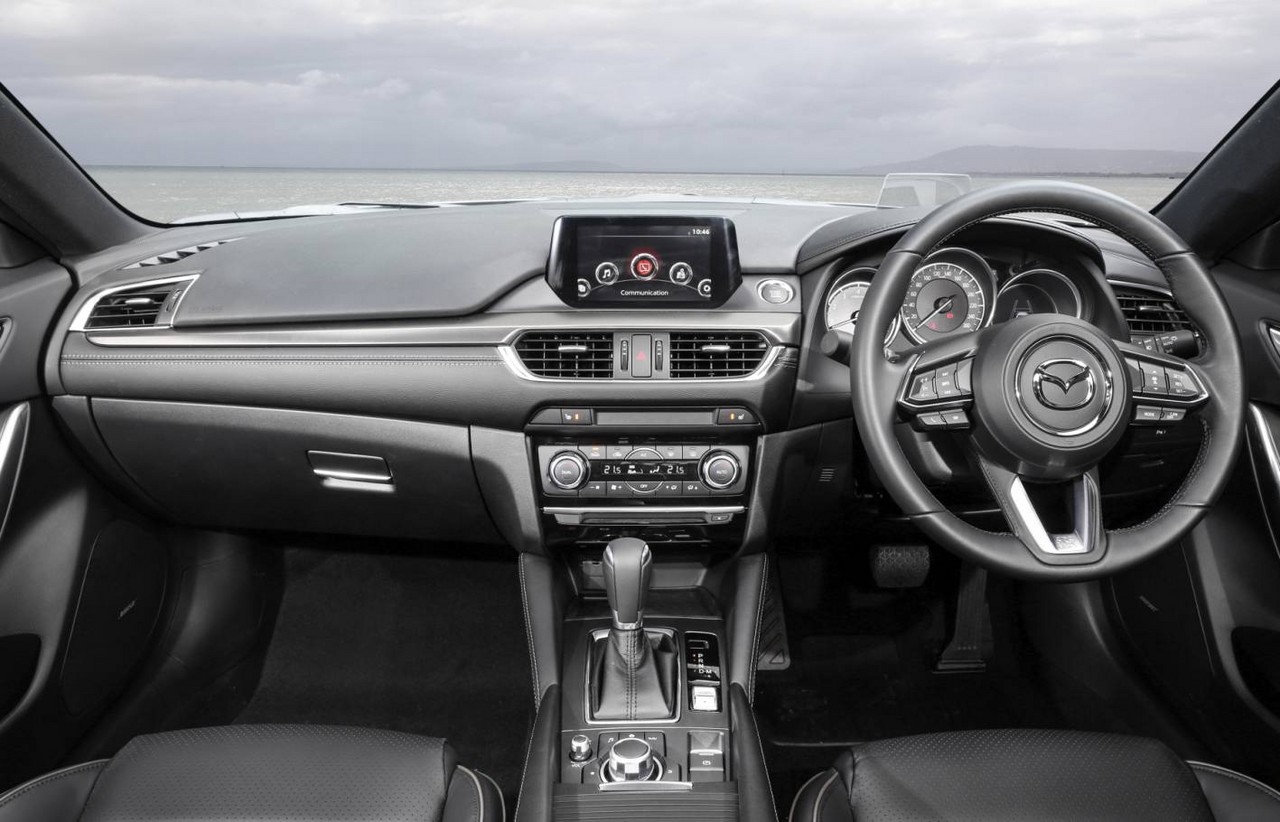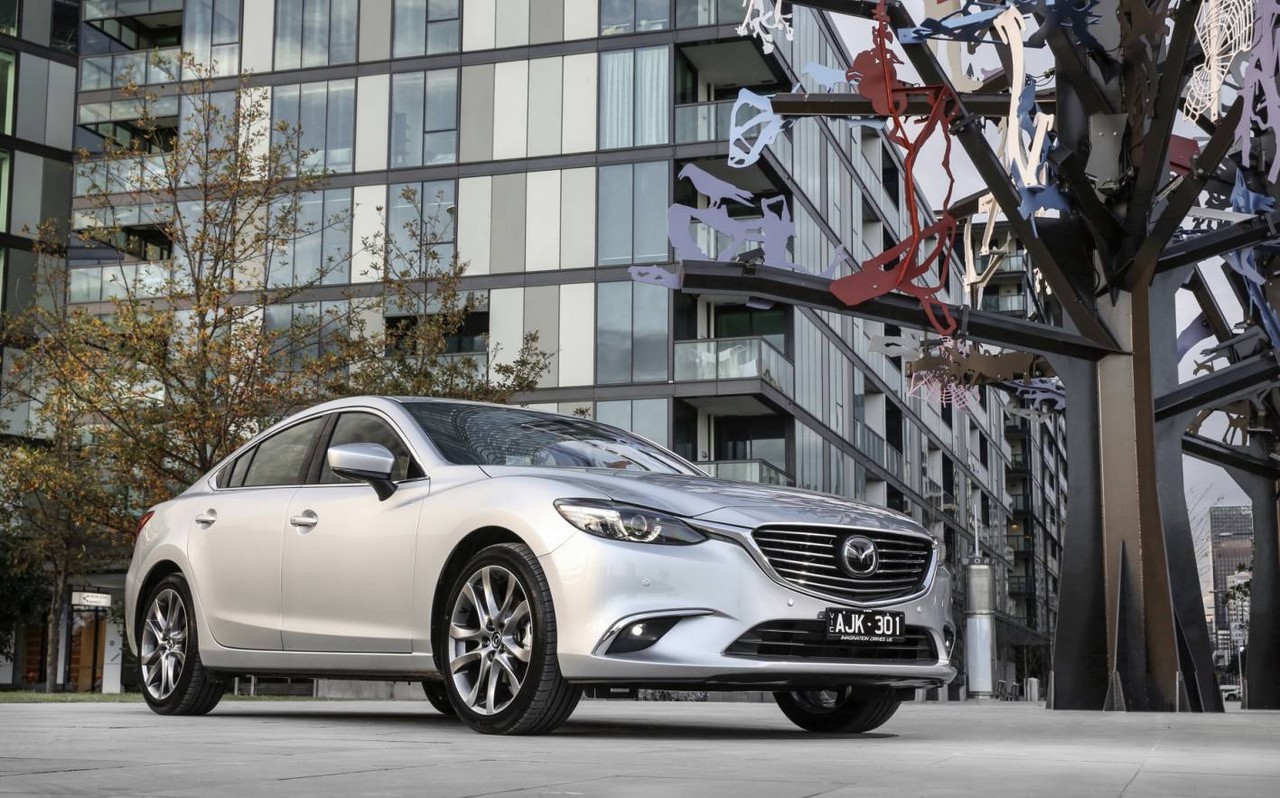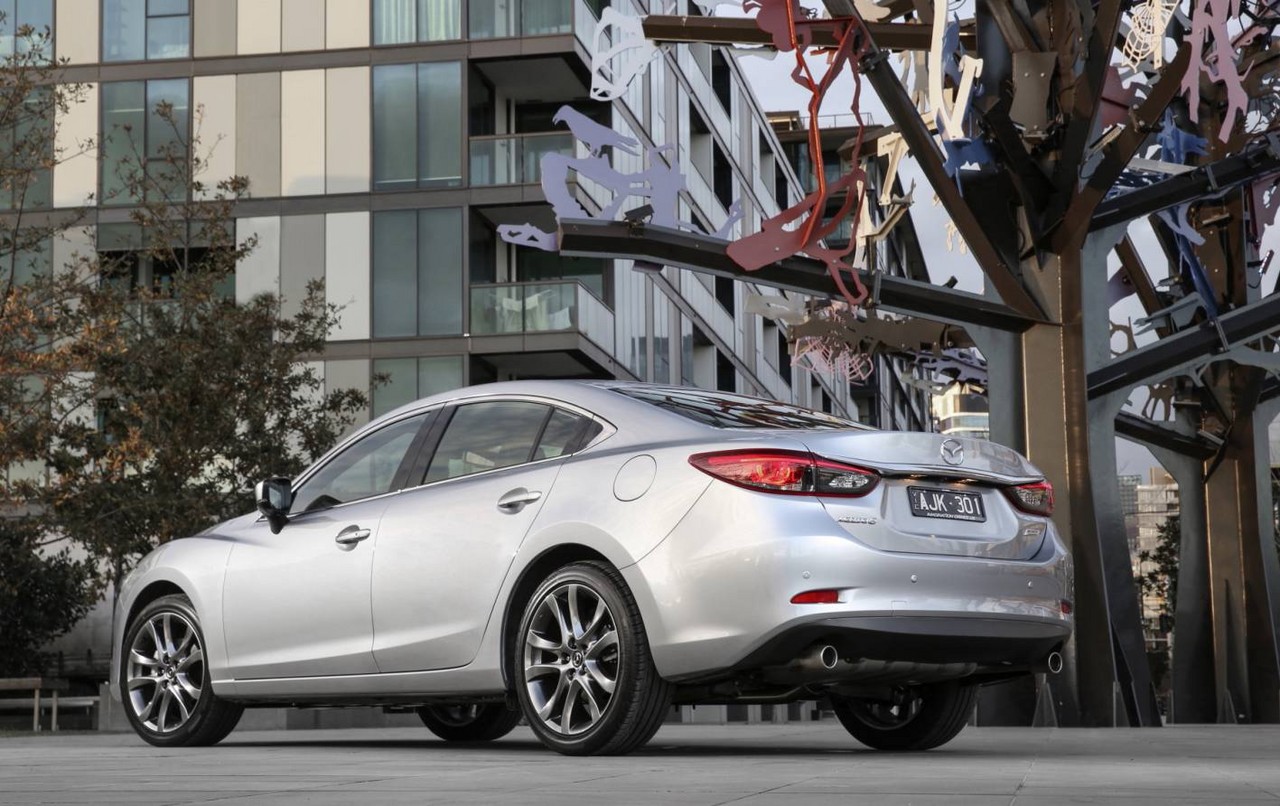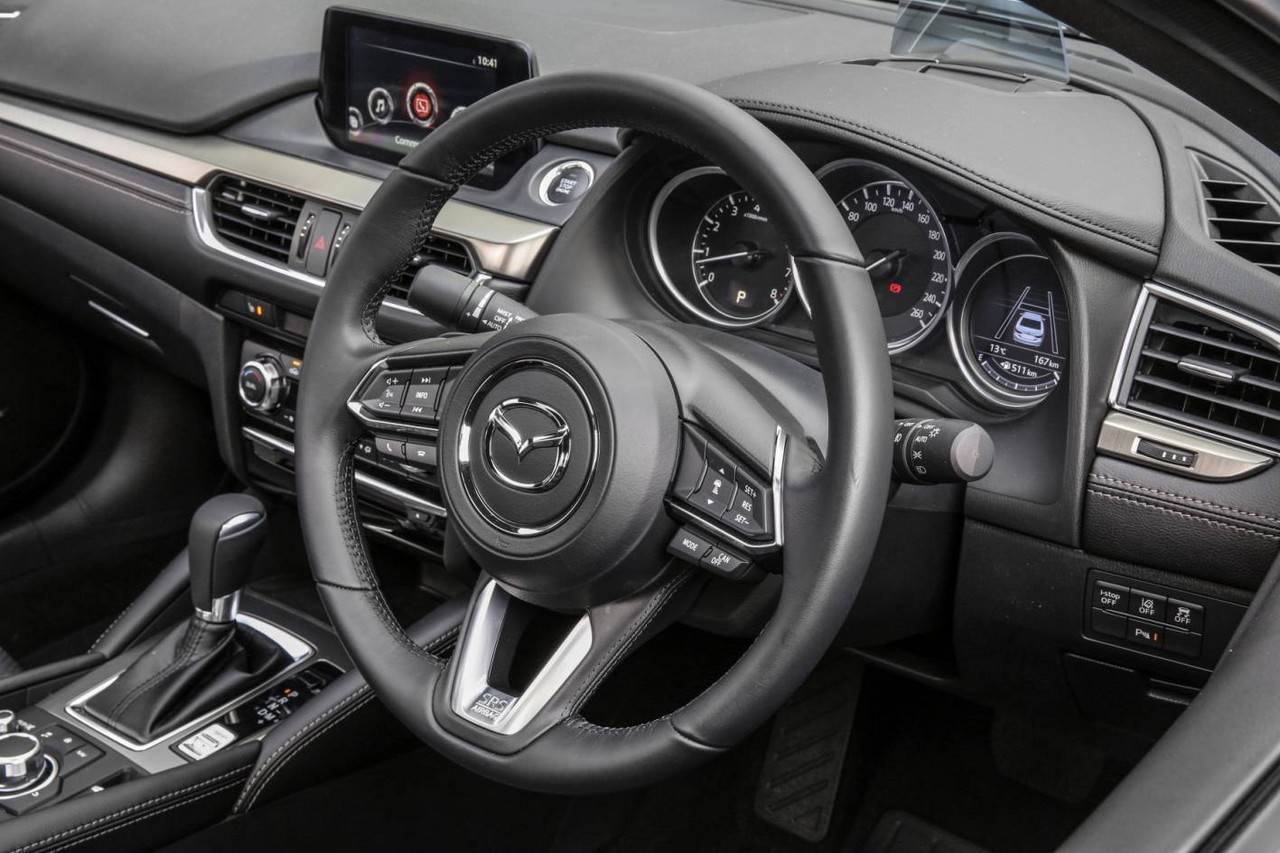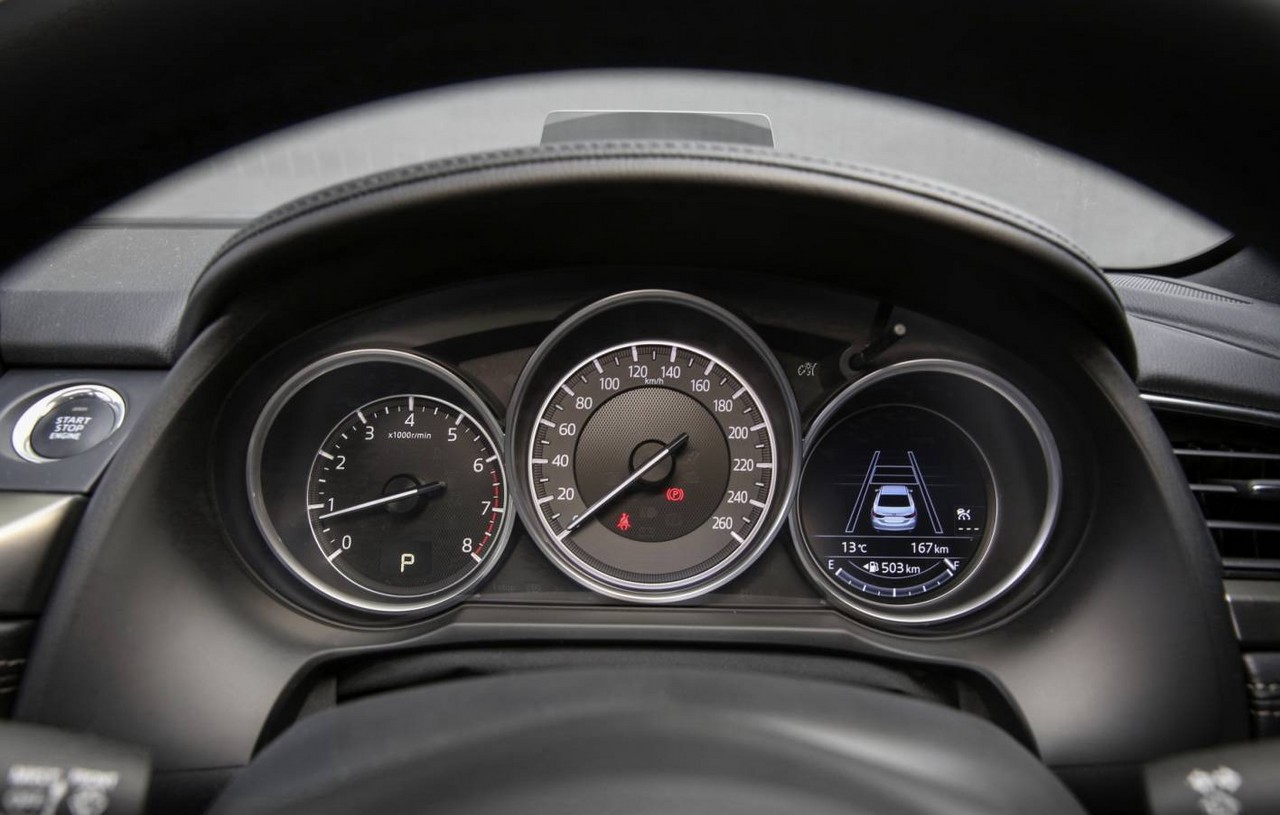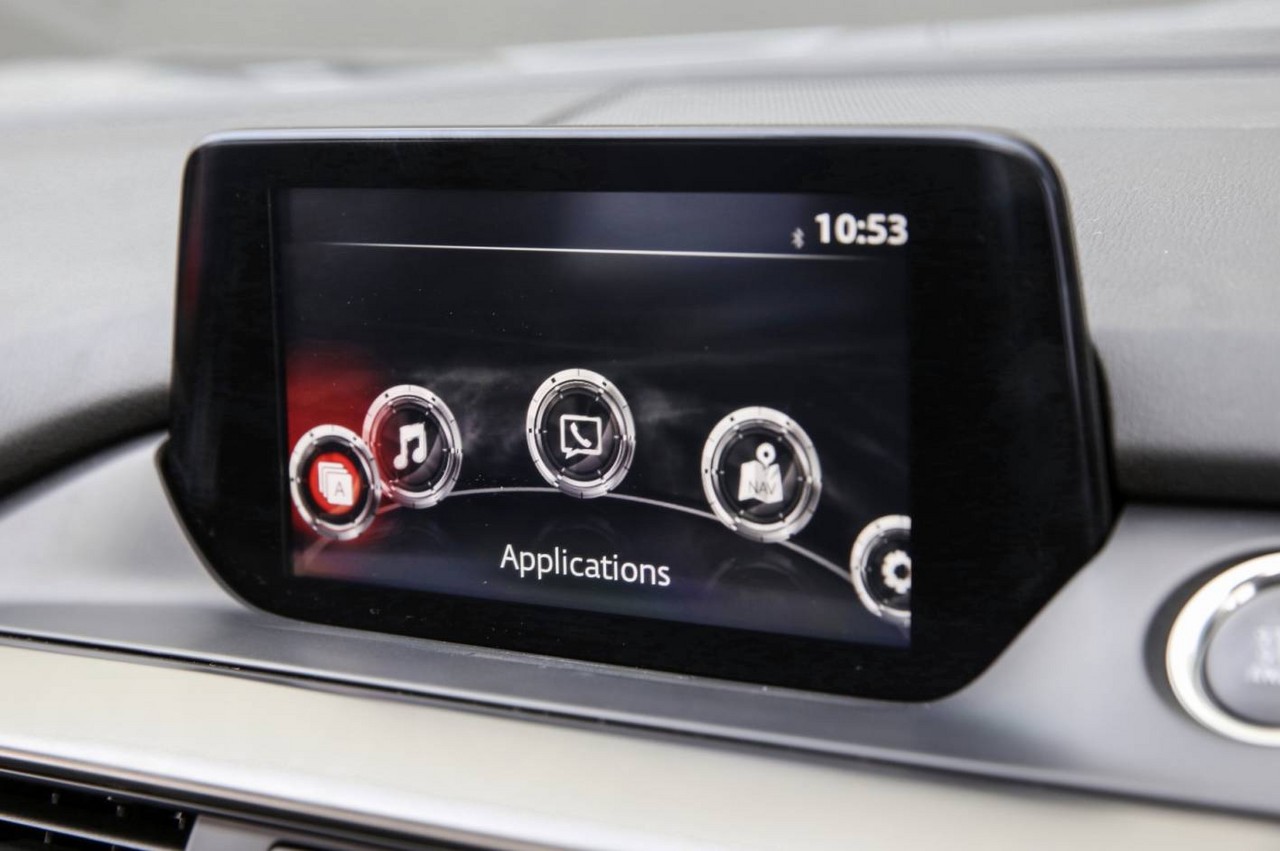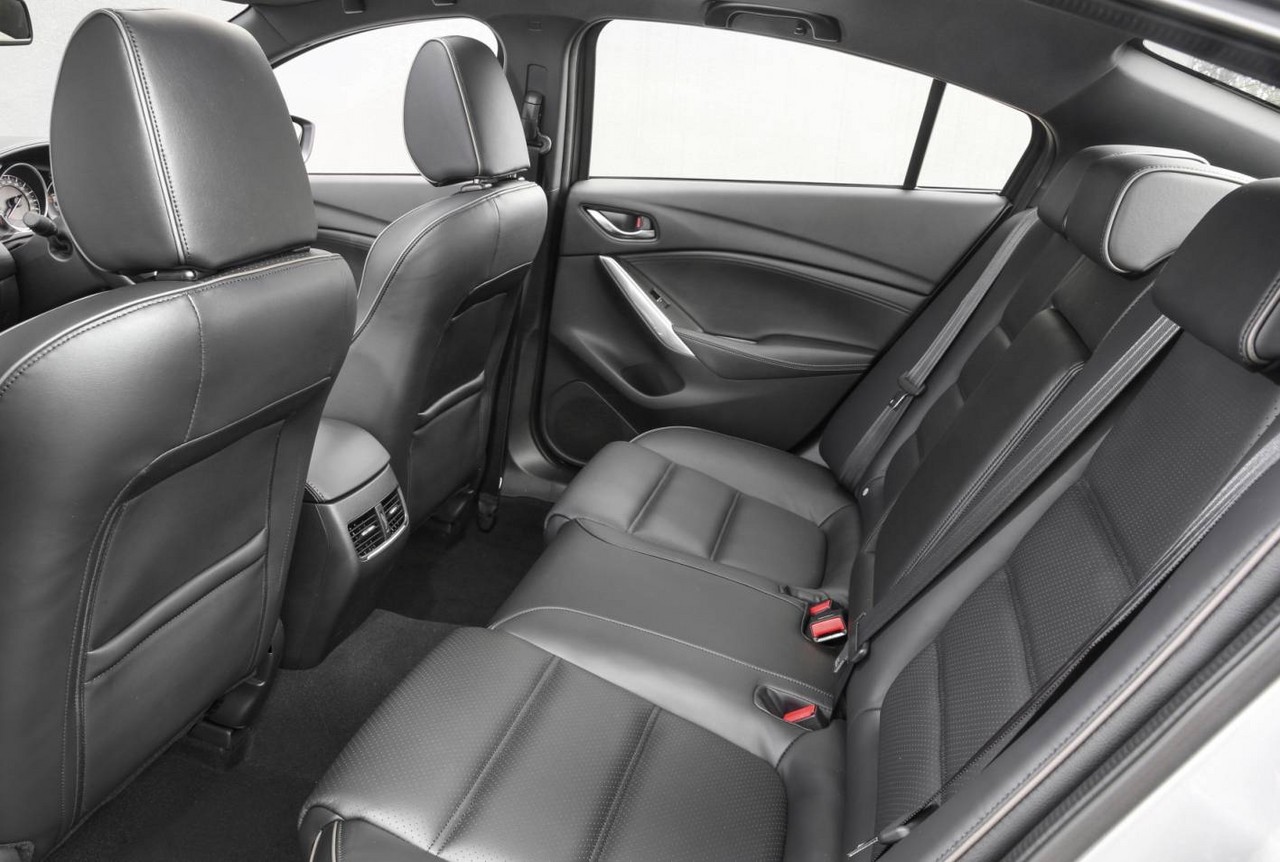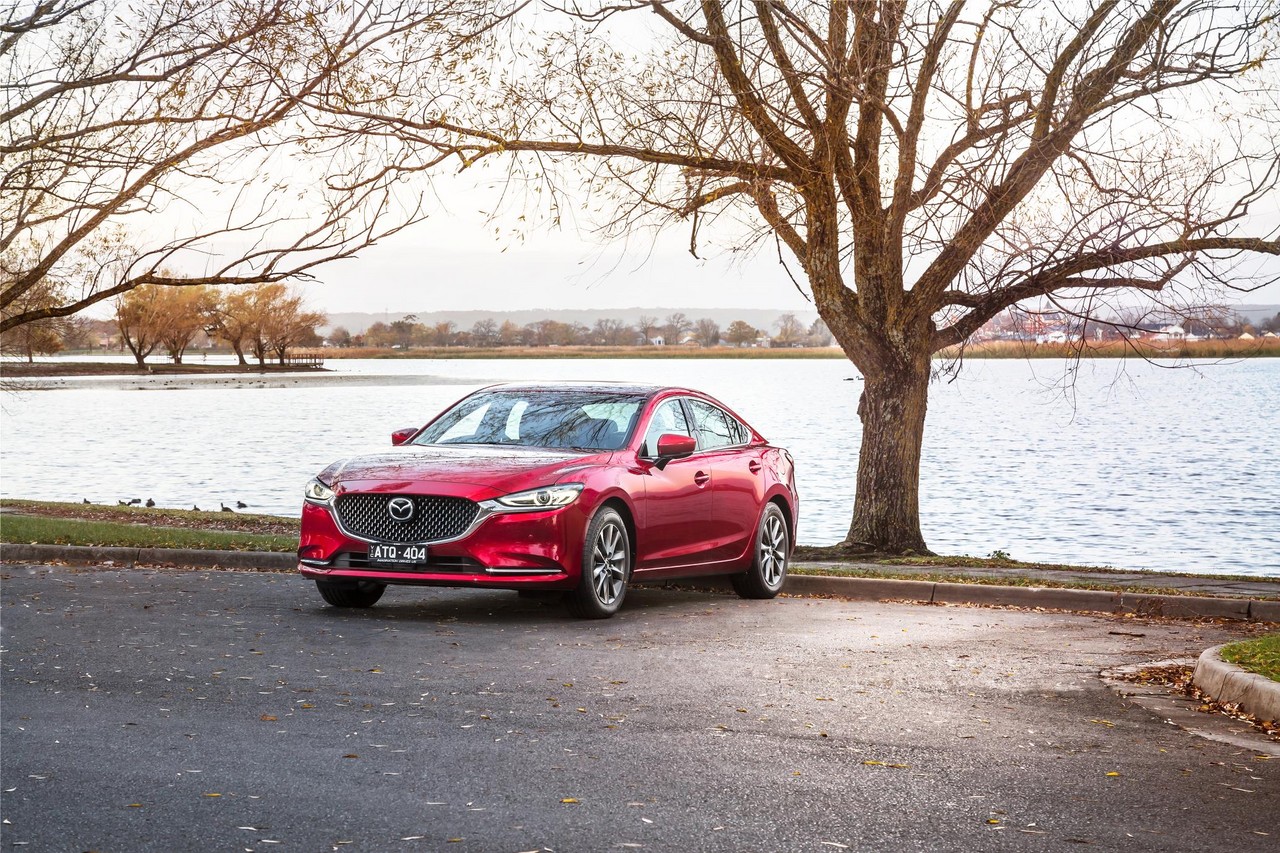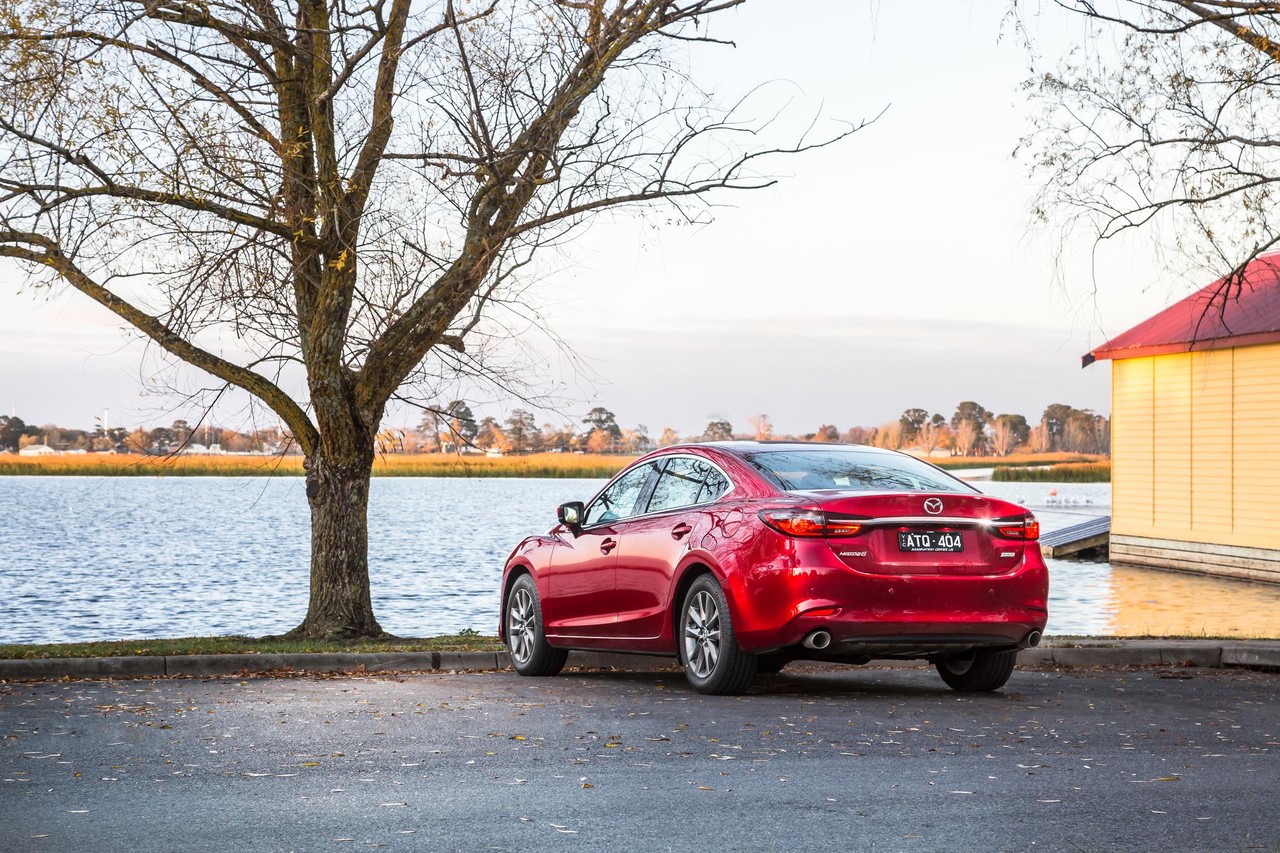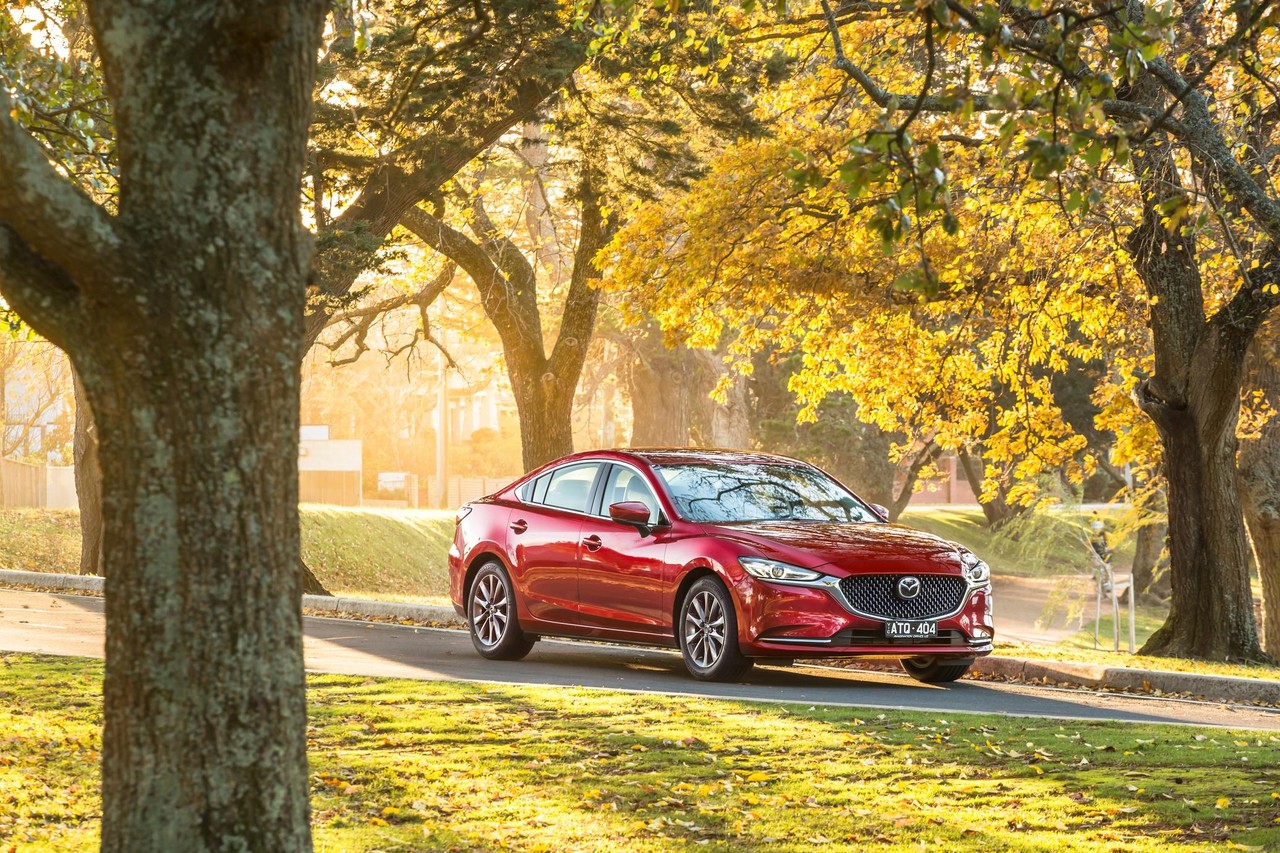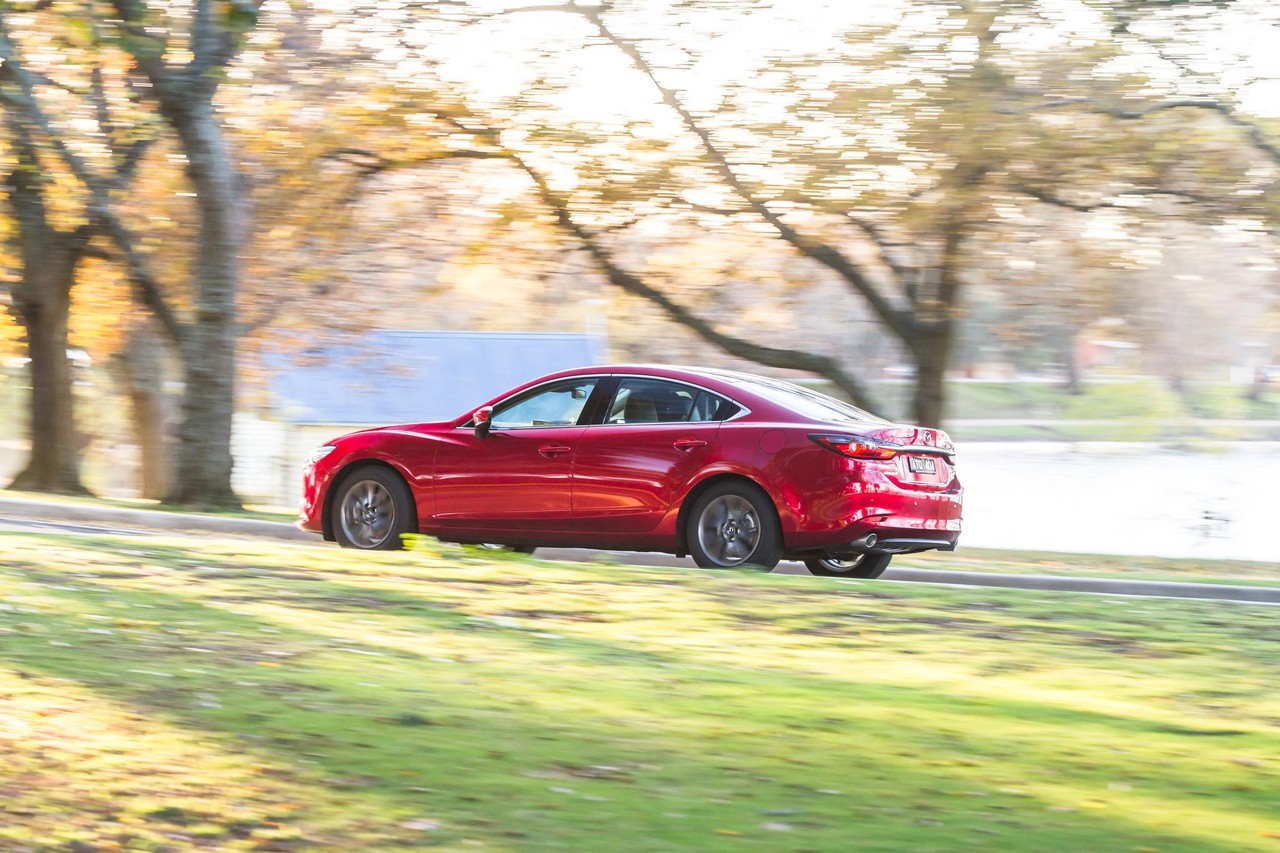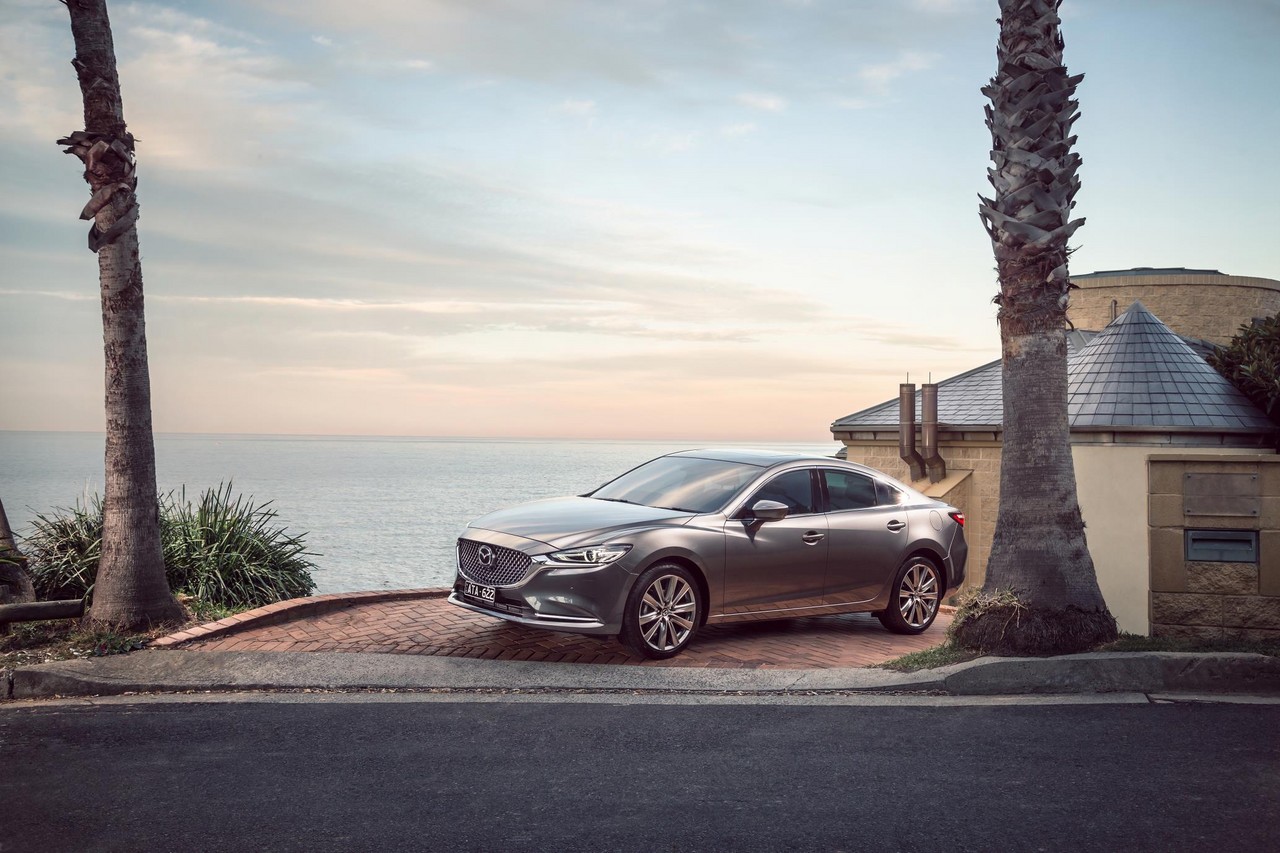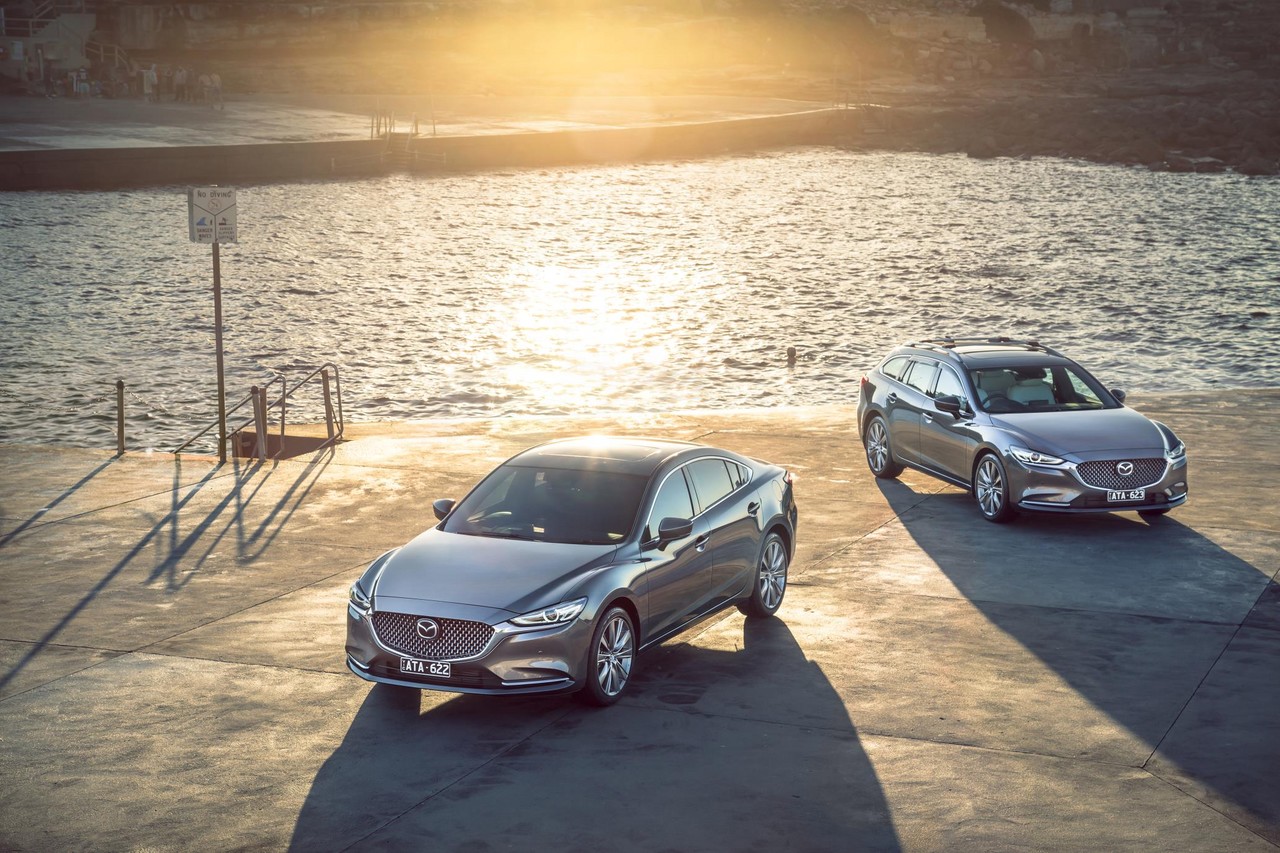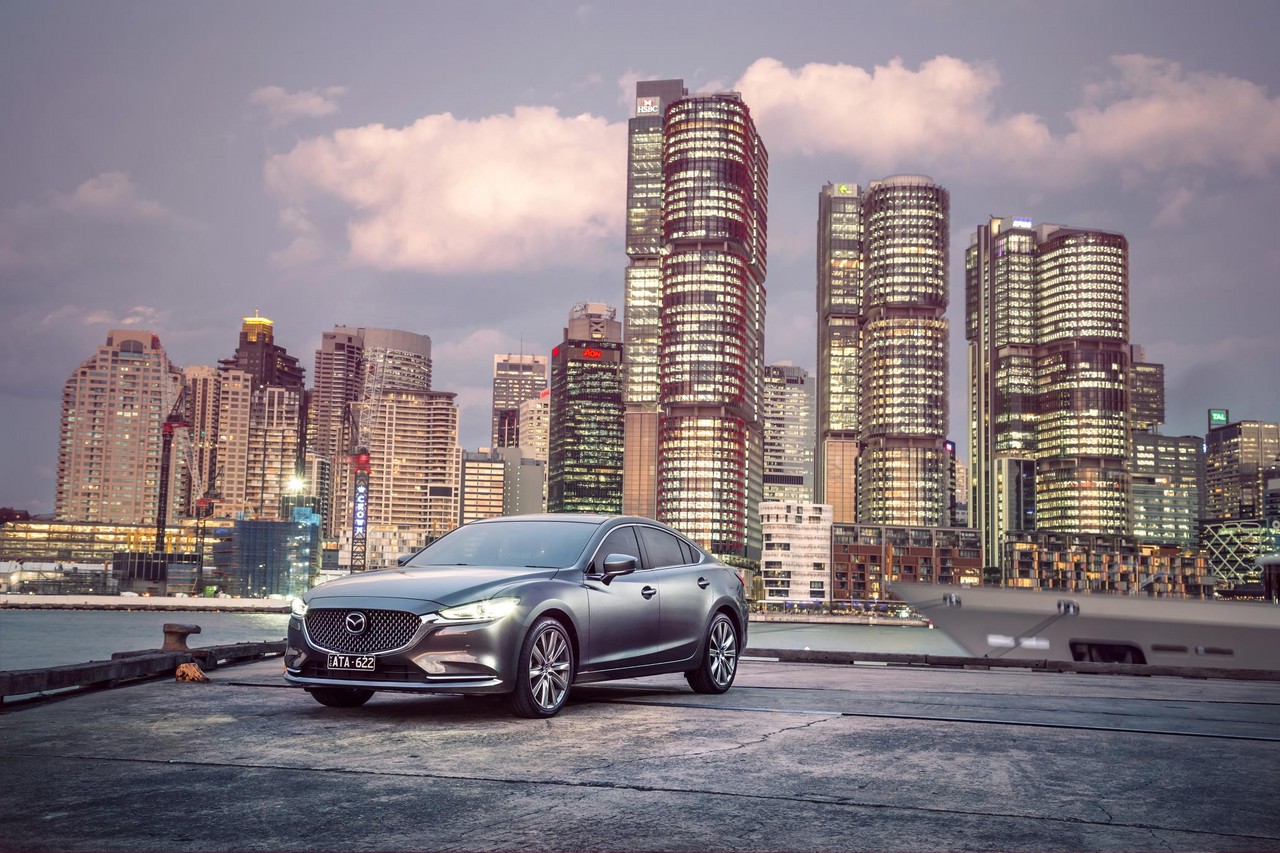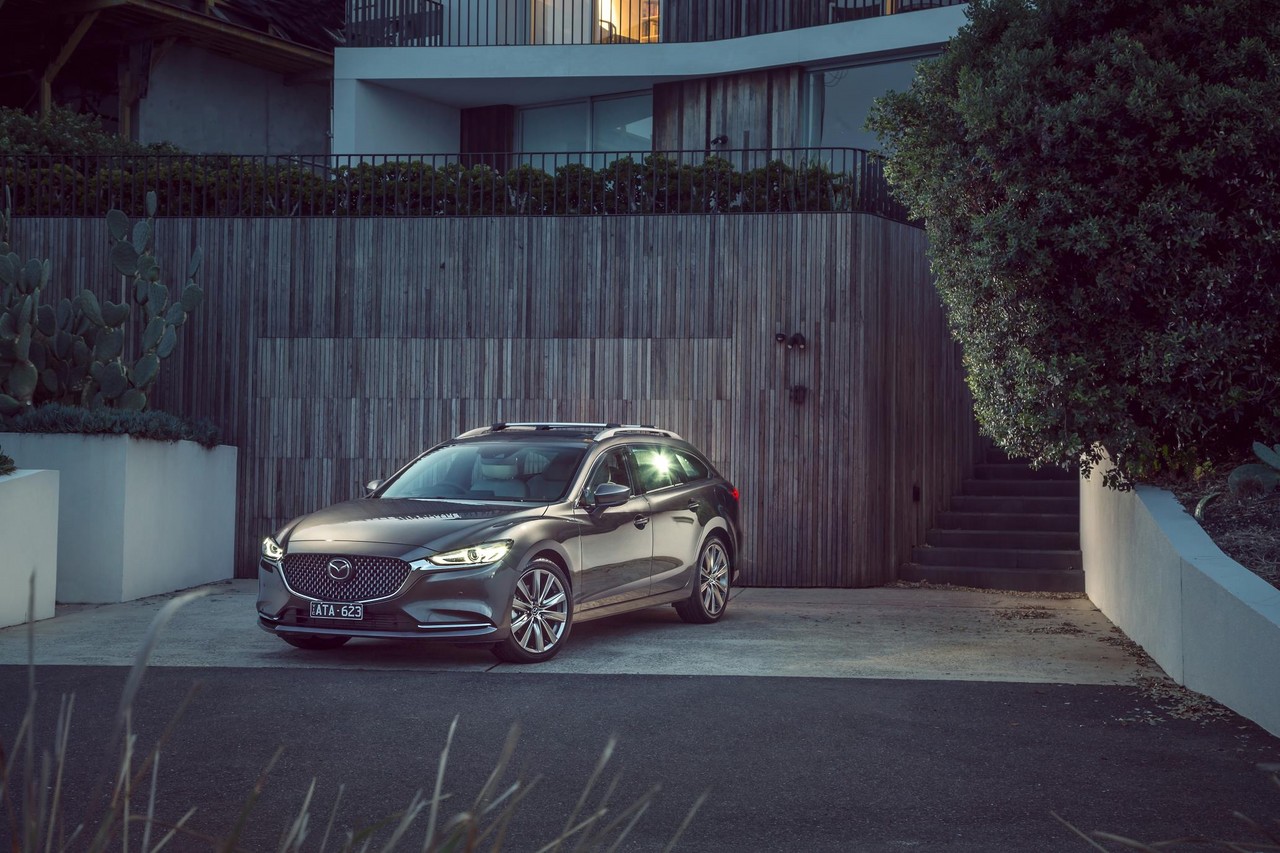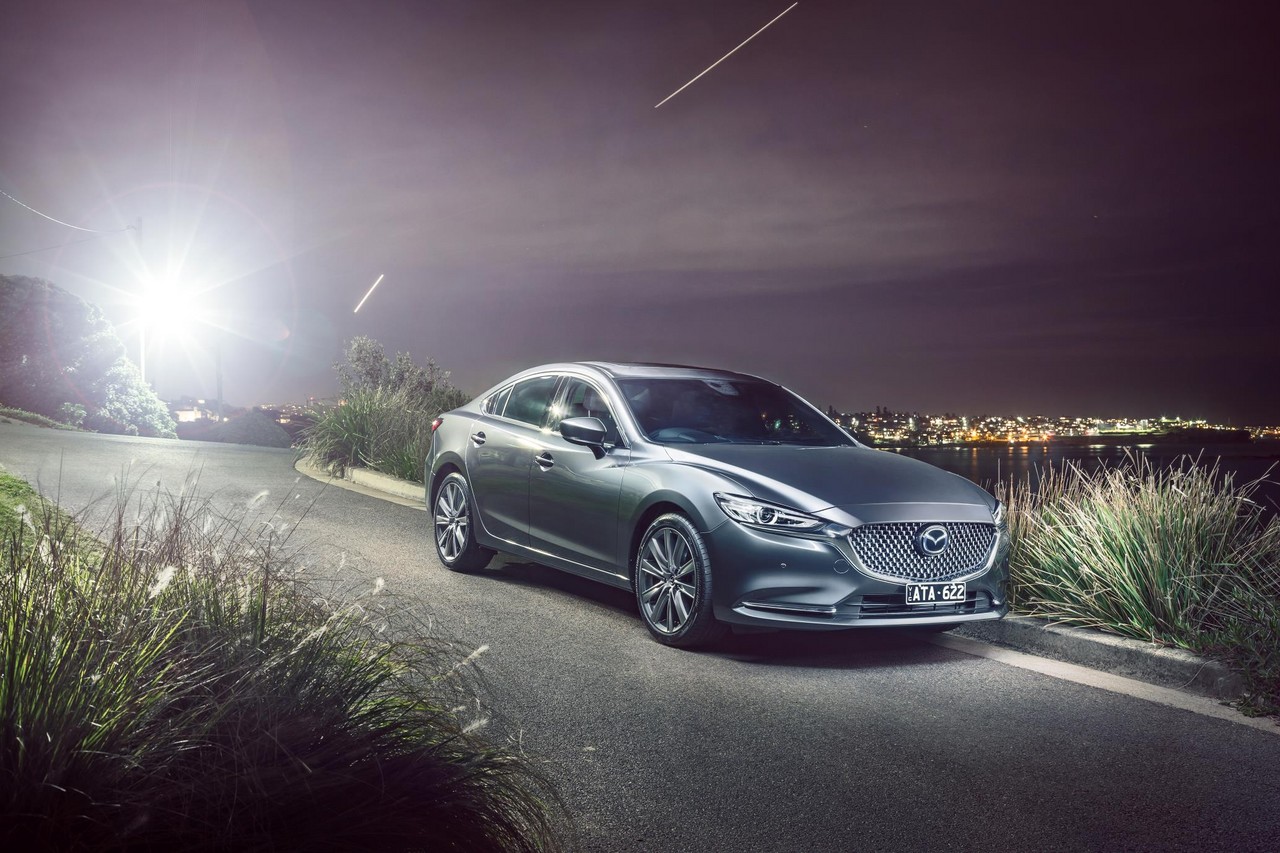
- Refined 2.5-litre petrol engine
- Responsive and economical 2.2-litre turbo-diesel engine
- High standard of interior fit and finish
- Accurate steering
- Generally impressive ride/handling balance…
- … though firm ride on 19-inch wheels
- Limited rear seat headroom
- Sedan has shallow boot
- Apple CarPlay and Android Auto only fitted from May 2019
Review: Mazda GL.I Mazda6 (2016-on)
Overview
Commencing production in July 2016 and officially released in Australia in September 2016, the Mazda GL Mazda6 was available as a mid-size sedan or wagon. Manufactured in Japan, the front-wheel drive GL Mazda6 was powered by Mazda’s SkyActiv 2.5-litre petrol and 2.2-litre turbo-diesel engines that were mated to six-speed automatic transmissions. Furthermore, the GL Mazda6 range consisted of Sport, Touring, GT and Atenza variants.
Comparison with Mazda GJ Mazda6
Compared to the Mazda GJ Mazda6 , the Mazda GL Mazda6 did not introduce any styling changes. Inside, however, the Mazda GL Mazda6 featured a new steering wheel with a smaller centre pad, simplified instrument display with clearer labelling and fonts (to match those on MZD Connect), full-colour Multi-Information Display in the meter cluster and the Active Driving Display (ADD) was enhanced with coloured graphics and could display Traffic Sign Recognition (TSR) information, water temperature gauge and a compass function.
The Mazda GL Mazda6 introduced Mazda’s ‘G-Vectoring Control’ (GVC) and was fitted with this technology as standard. As the steering wheel was turned, GVC would slightly reduce torque – usually by 0.01 g or less – to the front wheels to generate a small shift in load to the front axle and improve cornering response.
SkyActiv-G and SkyActiv-D engines
The 2.5-litre PY-VPR ‘SkyActiv-G’ petrol engine had an aluminium alloy block and cylinder head, a balance shaft, double overhead camshafts, four valves per cylinder, variable valve timing for the intake and exhaust valves (Mazda’s ‘dual S-VT’), a 4-2-1 exhaust system with an extended manifold structure to reduce residual exhaust gas in the combustion chamber, a special piston cavity to reduce cooling losses, direct injection and a compression ratio of 13:1.
The 2.2-litre SH-VPTR ‘SkyActiv-D’ diesel engine had an aluminium alloy block and cylinder head, double overhead camshafts, four valves per cylinder, common-rail direct-injection, two-stage turbocharging (i.e. a smaller turbine was used at low engine speeds, while a larger turbine would be used – exclusively – from mid-range engine speeds) and a compression ratio of 14.0:1 (the world’s lowest for a diesel engine).
For the Mazda GL Mazda6, the SkyActiv-D engine introduced the following technologies:
- Mazda’s ‘High-Precision DE Boost Control’ which provided more precise control of engine torque response by ‘optimising boost pressure control’ and enabling finer adjustment of fuel injection;
- Mazda’s ‘Natural Sound Smoother’ which sought to cancel piston vibration that was generated by extension and retraction of the connecting rod during combustion by placing a damper in the hollow part of the piston pin; and,
- Mazda’s ‘Natural Sound Frequency Control’ reduced engine knock by controlling injection timing so that sound waves introduced at pre-combustion, main combustion and post-combustion cancelled each other out.
Both engines were mated to six-speed automatic transmissions which could be controlled via steering-wheel gearshift paddles.
| Body | Variants | Engine | Trans. | Peak power | Peak torque |
|---|---|---|---|---|---|
| Sedan | Sport, Touring, GT, Atenza |
2.5-litre SkyActiv-G petrol I4 |
6sp auto | 138 kW at 5700 rpm | 250 Nm at 3250 rpm |
| Touring, GT, Atenza |
2.2-litre SkyActiv-D turbo diesel I4 | 6sp auto | 129 kW at 4500 rpm | 420 Nm at 2000 rpm | |
| Wagon | Sport, Touring, GT, Atenza |
2.5-litre SkyActiv-G petrol I4 |
6sp auto | 138 kW at 5700 rpm | 250 Nm at 3250 rpm |
| Touring, GT, Atenza |
2.2-litre SkyActiv-D turbo diesel I4 | 6sp auto | 129 kW at 4500 rpm | 420 Nm at 2000 rpm |
i-stop and i-ELOOP
For the GL Mazda6, all engines were fitted with Mazda’s ‘i-stop idle-stop’ system which enabled the engine to shut down when the vehicle was stationary to minimise fuel consumption. As standard, the GL Mazda6 was also fitted with Mazda’s ‘i-ELOOP’ system which captured kinetic energy when the driver lifted their foot off the accelerator and stored that energy in a capacitor to power the vehicle’s electrical systems and thereby reducing fuel consumption.
Dimensions and body
The Mazda GL Mazda6 sedan was 4865 mm long, 1840 mm wide, 1450 mm tall and had a 2830 mm long wheelbase. The GL Mazda6 wagon, however, was 65 mm shorter (at 4800 mm), 30 mm taller (1480 mm) and had an 80 mm shorter wheelbase (2750 mm). The boot of the Mazda6 sedan had a volume of 474 litres, while the luggage volume of the Mazda6 wagon was 506 litres (below the parcel shelf with the rear seats in position.
Compared to the Mazda GJ.II Mazda6, sound insulation for the GL Mazda6 was enhanced with upgraded door seals, tighter tolerances between panels, additional sound deadening materials for the underbody, rear console, headliner and doors, and laminated front side windows to reduce wind noise.
Suspension and steering
The Mazda GL Mazda6 had MacPherson strut front suspension and independent, multi-link rear suspension.
The Mazda GL Mazda6 had rack-and-pinion steering with electric power assistance. While the Mazda6 sedan had a turning circle of 11.2 metres, the turning circle for the Mazda6 wagon was 11.0 metres.
Safety equipment
Standard safety equipment for the Mazda GL Mazda6 included dual front airbags, front side airbags, full-length curtain airbags, ABS, electronic brake force distribution, brake assist, electronic stability control, traction control, active front seat head restraints and front seatbelts with pre-tensioners and load limiters.
Beyond this, the Mazda6 Sport, Touring and GT were equipped with the following i-ACTIVSENSE’ technologies:
- Smart City Brake Support – Forward/Reverse (SCBS F/R): operating at speeds between 4 km/h and 80 km/h, SCBS Forward used a near-infrared sensor that was mounted on the windscreen for ‘precision detection’ of objects up to six metres ahead of the vehicle. Furthermore, SCBS Reverse operated at speeds between 2 km/h and 8 km/h and used ultrasound sensors in the rear bumper to detect obstacles up to two metres behind the vehicle. When an obstacle was detected and a high risk of collision was determined, the brakes would be applied automatically to avoid or reduce the severity of the collision;
- Blind Spot Monitoring (BSM): used radar sensors to detect vehicles approaching from behind the vehicle. If the driver activated the indicators to change lanes while a vehicle was in the driver’s blind spot, the BSM system would issue a flashing visual indicator in the respective door mirror and sound a buzzer. BSM also included Mazda’s ‘Rear Cross Traffic Alert’ which could detect approaching traffic while the vehicle was reversing;
- Rear Cross Traffic Alert (RCTA): could warn the driver of approaching traffic when reversing from a parking space by sounding an audible alert and illuminating LED icons in the door mirrors; and,
- Driver Attention Alert (DAA): operating at speeds above 65 km/h, DAA would initially observe driver behaviour – such as steering wheel operation, vehicle speed and lane positioning – for 20 minutes to establish a benchmark. The DAA system would then monitor driver behaviour for signs of fatigue and recommended rest breaks if detected. Alerts would also be issued if the driver had been driving continuously for more than two hours.
Beyond this, both the Mazda6 GT and Atenza were fitted with Traffic Sign Recognition (TSR) which used the forward camera to identify traffic signs and relay this information to the driver on the Active Driving Display.
The Mazda GL Mazda6 Atenza was further equipped with the following ‘i-ACTIVSENSE’ technologies:
- Mazda Radar Cruise Control (MRCC): operating at speeds between 30 km/h and 145 km/h, MRCC used a milliwave radar to judge the relative speed of and distance to the vehicle ahead. In accordance with the target speed set by the driver, MRCC would adjust the vehicle’s speed to maintain a safe distance to the vehicle ahead;
- Lane-keep Assist System (LAS) and Lane Departure Warning (LDW): used a forward-sensing camera to monitor lane markings on the road surface and assisted the driver to stay in their lane by providing steering torque assistance and steering wheel vibration alerts. The driver could choose from ‘Early’ or ‘Late’ settings to adjust the level of assistance and the timing of its operation. In the ‘Early’ setting, for example, the system provided continuous steering assistance to keep the vehicle in the centre of its lane;
- Smart Brake Support (SBS): operating at speeds between 15 km/h and 160 km/h, SBS used milliwave radar and a forward sensing camera to detect vehicles or obstacles on the road ahead. If a potential collision was assessed, an initial alert would sound (Mazda’s ‘Forward Obstruction Warning’) and the brakes would be pressurised. In its secondary phase, SBS would apply the brakes lightly. If the vehicle could no longer avoid a collision, SBS would increase braking force to minimise the severity of the collision. In the event that the driver applied the brakes, braking force would be maximised; and,
- Adaptive LED Headlamps (ALH): combined ‘Glare-free High Beam’, which controlled the illumination coverage of the high beams, and ‘Wide-range Low Beam’, which expanded the area of illumination.
Brakes
The Mazda GL Mazda6 had 297 mm by 28 mm ventilated front brake discs and 278 mm by 10 mm solid rear discs.
Euro NCAP testing: Mazda GL Mazda6
In Euro NCAP testing , the Mazda GL Mazda6 Wagon received a five star safety rating which included a 95 per cent adult occupant protection rating and a 91 per cent child occupant protection rating. In the frontal offset test, protection of the front occupants was generally rated as good, though protection of the driver’s chest and lower right leg were rated as adequate (i.e. a slight risk of serious injury). Furthermore, maximum points were awarded in the side impact and pole tests.
Features: Mazda6 Sport
Standard features for the Mazda GL Mazda6 Sport included a six speaker sound system with digital radio tuner (DAB+), a CD player and auxiliary inputs (3.5 mm/USB/iPod), Bluetooth mobile phone connectivity and audio streaming, Internet radio integration, satellite navigation with a seven-inch colour touch screen (‘MZD Connect’), dual-zone climate control air conditioning, cruise control, black cloth seats, front fog lamps, automatic headlights, a reverse camera, rear parking sensors, a leather-wrapped steering wheel and gearshift lever, steering wheel gearshift paddles, 60:40 split and folding rear seats, remote central locking, power windows, power adjustable and heated door mirrors with folding function, tilt and telescopic steering wheel adjustment, an electric parking brake, a height adjustable driver’s seat, illuminated vanity mirrors, reading lamps, tinted windows, a trip computer and an immobiliser.
As standard, wagon models were also fitted with a 12 volt power outlet in the cargo area, a cargo cover, cargo net and roof rails.
Features: Mazda6 Touring
Compared to the Mazda6 Sport, the Mazda6 Touring was further equipped with a Bose sound system with a 231 watt amplifier and eleven speakers, black leather seats, an eight-way power adjustable driver’s seat, a four-way power adjustable front passenger seat, LED front fog lamps, LED daytime running lamps, front parking sensors, automatically folding door mirrors, driver’s seat memory settings and LED reading lamps.
Features: Mazda6 GT
Beyond this, the Mazda6 GT added heated front seats, directional headlights, proximity key, an electrochromatic rear-view mirror, power-operated glass sunroof and Mazda’s ‘Active Driving Display’ (ADD), a head-up display which projected speed, navigation directions and other driving information onto a clear panel that was mounted above the instrument cluster.
Features: Mazda6 Atenza
In addition to its ‘i-ACTIVSENSE’ safety technologies, the Mazda6 Atenza was also fitted with LED headlights.
The Mazda6 Atenza, however, could be specified with an optional, extra-cost ‘premium interior package’ which included nappa leather seats with titanium piping, titanium trim highlights (for the instrument panel, centre console and door trims), black headlining with overhead console LED down-lighting, chrome-plated seat adjustment controls and a glovebox latch.
Brochure
Review: Mazda GL.II Mazda6 (2018-on)
Overview
Released in June 2018, the Mazda GL Series II (GL.II) Mazda6 introduced 2.5-litre turbocharged ‘SkyActiv-G’ petrol engines that were shared with the Mazda TC CX-9, updated styling and interiors, a stronger body and improved sound insulation.
In May 2019, however, the Mazda GL.II Mazda6 range was revised as diesel engines were withdrawn.
Styling and interior
Visually, the GL.II Mazda6 could be identified by its new grille with recessed mesh, standard LED headlights with integrated fog lamps, new 17- and 19-inch wheel designs and, at the rear, body-coloured lower rear bumper section.
Inside, the re-shaped front seats for the GL.II Mazda6 had thicker urethane for the seatbacks, improved back support, wider seat cushions with vibration-absorbing urethane foam, larger side bolsters and re-shaped head restraints. Other changes included an eight-inch colour touch screen (previously seven-inch) and ‘refined’ instrument panel and door trims, while Mazda’s ‘Active Driving Display’ – which projected vehicle information onto the inside of the windscreen – was fitted as standard.
SkyActiv-G engine: cylinder deactivation
For the Mazda GL.II Mazda6, the naturally aspirated 2.5-litre ‘SkyActiv-G’ petrol engine introduced a cylinder deactivation function which used a mechanism in the hydraulic lash adjusters to shut down cylinders #1 and #4 when the vehicle was operating at steady speeds between 40 km/h and 80 km/h. At a constant speed of 80 km/h, cylinder deactivation could improve fuel economy by five per cent. Because the firing interval was double when the engine was running on two cylinders, a centrifugal pendulum dampener was introduced for the six-speed automatic transmission’s torque converter to reduce vibrations.
Other changes for the 2.5-litre ‘SkyActiv-G’ petrol engine included:
- A re-shaped air intake port to increase tumble flow;
- Shorter piston crowns;
- Revised piston skirt curvature;
- Asymmetrical piston rings which had a larger outer radius at the top and a smaller radius at the bottom edge;
- A Coolant Control Valve which reduced coolant flow around the walls of the combustion chamber after start-up for faster warm-up;
- Increased fuel injection pressure (30 MPa, previously 20 MPa);
- A variable displacement oil pump; and,
- An active grille shutter in front of the radiator.
SkyActiv-D engine
For the Mazda GL.II Mazda6, changes for the 2.2-litre SkyActiv-D engine included:
- For the larger turbocharger, a variable geometry function which could change the angle of vanes to vary the area of the turbine inlet;
- Stepped, egg-shaped piston bowls;
- A higher compression ratio of 14.5:1 (previously 14.0:1);
- Ultra-high response, multi-hole piezo injectors;
- Sodium-filled exhaust valves; and,
- A Coolant Control Valve which reduced coolant flow around the walls of the combustion chamber after start-up for faster warm-up.
SkyActiv-G 2.5T engine: Mazda6 GT and Atenza
Previously introduced in the Mazda TC CX-9, the Mazda GL.II Mazda6 GT and Atenza were available with a 2488 cc ‘SkyActiv-G’ turbocharged petrol engine. Based on the naturally aspirated 2.5-litre SkyActiv-G engine, the SkyActiv-G 2.5T engine featured Mazda’s ‘Dynamic Pressure Turbo’ which could vary the degree of exhaust pulsation according to engine speed (in contrast to variable geometry turbochargers which adjust the speed or direction of exhaust gas flowing into the turbine). The Dynamic Pressure Turbo operated as follows:
- At low engine speeds (below 1620 rpm), the size of the exhaust ports were reduced by closing a series of valves (located just before the turbine) which drove the turbocharger – this reduced interference between exhaust pulses and enables the turbocharger to spool up quickly, up to a maximum pressure of 1.2 bar (17.4 psi); and,
- At higher engine speeds, the secondary valves opened to allow a greater volume of exhaust gas to pass through the turbocharger.
The SkyActiv-G 2.5T engine also had:
- Mazda’s ‘i-stop’ which enabled it to shut down when the vehicle was stationary in traffic;
- A 4-3-1 exhaust whereby the exhaust from the middle two cylinders (2 and 3) was joined into a single port, while the exhausts from the outer cylinders (1 and 4) had their own ports. The three ports merged at the entrance to the turbocharger’s exhaust side such that there was one pulse arriving every 180 degrees of crankshaft rotation. This kept exhaust pulses separate for maximum energy extraction and each exhaust pulse was harnessed to extract residual exhaust gas from the adjacent ports; and,
- A cooled exhaust gas recirculation (EGR) system which allowed the engine to maintain a stoichiometric air:fuel ratio (14.7:1) over a wider output range.
The SkyActiv-G 2.5T engine, however, did not have i-ELOOP.
| Body | Variants | Engine | Trans. | Peak power | Peak torque |
|---|---|---|---|---|---|
| Sedan | Sport, Touring |
2488 cc petrol I4 | 6sp auto | 140 kW at 6000 rpm | 252 Nm at 4000 rpm |
| Touring, GT, Atenza |
2191 cc biturbo diesel I4 | 6sp auto | 140 kW at 4500 rpm | 450 Nm at 2000 rpm | |
| GT, Atenza |
2488 cc turbo petrol I4 | 6sp auto | 170 kW at 5000 rpm | 420 Nm at 2000 rpm | |
| Wagon | Sport, Touring |
2488 cc petrol I4 | 6sp auto | 140 kW at 6000 rpm | 252 Nm at 4000 rpm |
| Touring, GT, Atenza |
2191 cc biturbo diesel I4 | 6sp auto | 140 kW at 4500 rpm | 450 Nm at 2000 rpm | |
| GT, Atenza |
2488 cc turbo petrol I4 | 6sp auto | 170 kW at 5000 rpm | 420 Nm at 2000 rpm |
Body and sound insulation
The Mazda GL.II Mazda6 introduced reinforcements to reduce vibrations that could affect occupant comfort. As such, changes included:
- A thicker cowl cross-member (which adopted an S-shaped cross-section structure);
- Two joints in each suspension top (previously one);
- Increased rigidity and strength between the front suspension tops;
- Larger tunnel members with four securing joints (previously three);
- Thicker left and right floor panels to enhance body rigidity;
- Thicker inner walls for the rear wheel housings;
- Stronger rear suspension trailing link mount gussets; and,
- Spherically-shaped plates (previously saddle-shaped) above the rear suspension mounts.
Beyond this, the following measures were introduced to reduce interior noise:
- Thicker floor panels;
- Fewer gaps between body panels or interior materials (including carpet cut-outs);
- Additional vibration-absorbing materials for the central tunnel; and,
- A new structure for the headlining.
Finally, the Mazda GL.II Mazda6 introduced the following aerodynamic enhancements:
- Front spoiler ducts to improve airflow;
- Smoother, flatter shapes for the engine’s under tray and the centre floor cover (the latter made from a lighter material with better noise-insulation properties);
- Optimised front tyre air deflectors and mudguards; and,
- Aerodynamic covers fitted beneath the suspension’s lateral links and rear bumper.
Suspension
For the Mazda GL.II Mazda6, the front steering knuckles were lowered to achieve more neutral steering characteristics, while lower arm height was raised. Beyond this, the front and rear stabilisers were bonded to the mount bushings for a smoother suspension stroke and front spring load was optimised. Other changes included:
- Revised bump-stop characteristics;
- The addition of rebound springs to the front dampers;
- 35 mm diameter front shock absorbers (previously 32 mm);
- Revised damper valve structures; and,
- The introduction of urethane in the rear damper top mounts.
Steering
For the Mazda GL.II Mazda6, rigid mounts were used attach the steering gearing to the suspension cross-member. According to Mazda, this provided a ‘more neutral steering feel’ while also increasing overall rigidity.
Safety equipment
For the Mazda GL.II Mazda6, standard safety equipment was extended to include:
- Mazda Radar Cruise Control with stop & go (MRCC). For the GL.II Mazda6, MRCC used the millimetre-wave radar and added a forward-facing camera to reduce its minimum operating speed from 30 km/h to zero. Furthermore, the system could be activated while the vehicle was stationary;
- Forward Obstruction Warning (FOW);
- Lane Departure Warning (LDW);
- Lane-keep Assist System (LAS);
- Smart Brake Support (SBS);
- Driver Attention Alert (DAA);
- Traffic Sign Recognition (TSR); and,
- Intelligent Speed Assist (ISA): alerted drivers when they exceeded the speed limit.
The Mazda GL.II Mazda6 also introduced an ‘active bonnet’. In the event of a pedestrian collision, the trailing edge of the bonnet would rise to create additional space between the bonnet and hard structures in the engine bay, thereby reducing the likely severity of pedestrian injuries.
Features: Mazda GL.II Mazda6
For the Mazda GL.II Mazda6, standard features were extended to include an eight-inch display with greater colour contrast for the MZD Connect infotainment system, LED headlamps, Mazda’s ‘Active Driving Display’ (i.e. head-up display), and a height adjustable front passenger seat. Other new features included:
- Front and rear courtesy lamps: when the doors were opened, white lamps would illuminate the area around the feet and red lamps would warn approaching vehicles that some was entering or leaving the vehicle; and,
- An ‘auto hold’ electric parking brake that would keep the vehicle stationary after the driver released the brake pedal. As such, the parking brake would only be released when the driver pressed the accelerator. This function could also be switched on/off via a centre console-mounted switch.
For the Mazda GL.II Mazda6 Touring, standard features were extended to include a ten-way power adjustable driver’s seat (previously eight-way) and advanced keyless entry (previously limited to the GT and Atenza variants).
The Mazda GL.II Mazda6 GT gained heated rear seats, but was no longer fitted with a power sunroof as standard.
For the Mazda GL.II Mazda6 Atenza, standard features were extended to include ventilated front seats, a seven-inch TFT digital instrument display, a frameless rear view mirror, door pocket lamps (front and rear) and a 360 degree view Monitor which used four cameras positioned around the vehicle to generate an overhead view of the vehicle that could be shown on the central display. The interior of the Mazda6 Atenza was updated to utilise ‘authentic Japanese materials that evoke a sense of classic Japanese design’, including:
- Walnut Brown nappa leather seats ‘inspired by the aged wood in ancient Japanese temples’ (though Pure White nappa leather was available as an option);
- UltraSuede NU door and dashboard trim inserts which had a subtle gold tint ‘similar to of ornate kimonos’; and,
- Sen wood accents (a timber used in taiko drum and Japanese furniture).
May 2019 update
In May 2019, the GL.II Mazda6 range was revised as diesel engines were withdrawn from the Australian market. Furthermore, Mazda’s G-Vectoring Control Plus (GVC Plus) was made standard across the range. In addition to the reduction in engine torque of GVC, GVC Plus applied light braking force to the outer wheels when cornering as the steering wheel returned to the centre position, providing a ‘recovery moment’ to restore the vehicle to straight line running. As such, the vehicle was more stable after initial emergency avoidance actions and when driving on slippery surfaces.
As part of the May 2019 update,
- A second antenna was fitted to improve FM radio reception;
- Standard features were extended to include Apple CarPlay and Android Auto smartphone integration, and tyre pressure monitoring; and,
- The Mazda6 Atenza was equipped with a heated steering wheel.
Brochure
Related links

